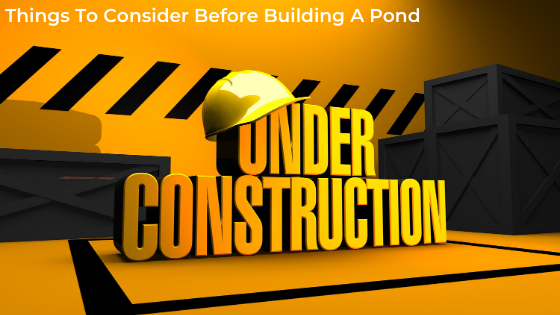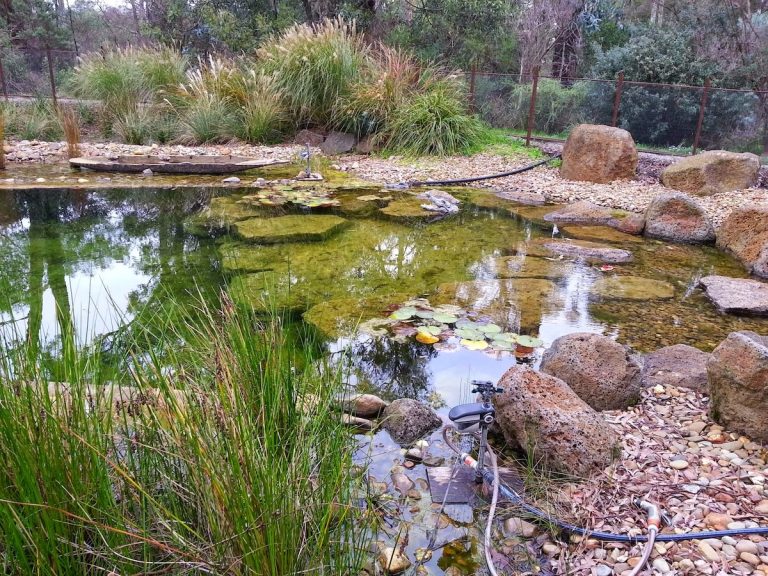Things To Consider Before Building A Pond
The first step in any construction project is always creating a plan.
While you don’t need to have decided every tiny detail down to the last fish and plant before getting started, it pays to at least have an idea of what types (if any) you want in your pond as it’s paramount to having the construction basics sorted.
It’s the logical conclusion that you’re going to want to determine the size, material and location of your pond before going any further, but this isn’t always as simple as it sounds.
Below you’ll find a general guide to things you should consider when determining the main characteristics of your pond:
Size
You don’t want to build a pond that is too small for your intended purpose which is why it’s a good idea to know what you want to use the pond for before you pick up a shovel. The length and width of your pond will generally be determined by three factors:
- Available space.
- Aesthetic preference.
- Whether it is of large enough dimensions to provide suitable habitat if you intend on stocking fish.
Selecting the depth of your pond, however, is a little more complicated:
- Shallow ponds require more complex care than their deeper counterparts. This is because they are more easily influenced by external factors and will experience significant fluctuation in conditions due to this. If your pond is intended as a purely ornamental water feature, this isn’t such an issue but if you wish to stock fishy friends or have aquatic plants that are a bit more picky about their environment, it is recommended to go with a deeper pond.
- If stocking fish, your pond should be deep enough to provide adequate protection against the elements and predators. Generally speaking, anything deeper than 600mm will be sufficient for protection from high temperatures, however certain species of fish have special requirements that will need to be met in order for them to flourish, so make sure you do your research before starting construction if you have your heart set on a particular breed.
- You should also consider whether you want your pond to be of uniform or varied depth. This decision will be based on a mixture of form and function. For example, formal water features tend to feature a single depth but those who wish to have a ‘Natural Pond’ or stock varied fish and plants will be better off with a more flexible construction approach.
- Ponds that are deeper than a certain level may require the installation of fencing or other safety precautions. Please check your local legislation to ensure compliance.
Material
The material from which you construct your pond will most likely be decided by your preferred aesthetic. Those who desire a more natural look are best sticking with a quality EPDM liner whereas those hunting a more formal feel could consider a concrete, paved or even ceramic construction.
The main thing to be aware of here is that different build materials will have different maintenance requirements. A liner for example, will perform best when paired with an underlay to help prevent damage and as EPDM is tough but flexible, it is unlikely to be damaged by soil movement. More rigid construction materials allow for cleaner lines and aesthetic but are more susceptible to damage from external factors and can even be broken down by the water in your pond over time if not correctly sealed and maintained.
Location
Ponds are one of those landscaping fixtures that once they’re in, they’re there to stay. It’s not impossible to move a pond but it is time consuming and highly impractical so getting your location right the first time around is paramount.
Many factors will determine where the best place for you to place your pond is but some of the most important ones to consider are:
Can you easily access power and water from your proposed location?
Your pond is going to need a power supply for your filtration and aeration systems and, like any other water body, is subject to evaporation from time to time. We recommend ensuring that you have easy access to both of these commodities in order to make running and maintaining your aquatic ecosystem easier.
Is your chosen area flat?
It is recommended that the ground level be equal at all areas of the perimeter. This helps prevent issues with lining or sealing, provides a safer environment for fishy friends as they’re less likely to be sucked out of a low point during heavy rainfall and just generally looks nicer than having a large dirt bank.
How much sunlight will your pond receive at any given point of the yard?
Sunlight is great for helping desired aquatic plants flourish and it can be nice to relax in the sun next to your fishy friends but it is important to remember that too much sunlight will lead to algae that is harder to control than it needs to be. To help minimise issues like this, it is advisable to position your pond in a location where it will get light of a morning and shade of an afternoon.
Are there trees or tall flowering plants that will overhang the pond?
Organic waste dropping from these kinds of plants will undoubtedly end up in your water. Besides detracting from your enjoyment of your pond as you’ll be forever skimming them off the surface, any that are not removed promptly enough will settle at the bottom and start decaying. This leads to a whole host of nutrient issues and can be detrimental to the health of your fishy friends.
Is your pond in a position where water will run from other points in the yard?
Any chemicals or pet waste present in your yard can contaminate your pond and cause health issues for your fish and aquatic plants if run off from other areas can find its way into your water. The best way to avoid this is to place your pond at one of the highest points in your yard but if this isn’t possible, make sure you have barriers in place that will either absorb or divert run off.
Can you easily see the prospective area from your home?
Things that are out of sight often also end up out of mind. To ensure you get maximum enjoyment from your new water feature (and keep it in the best condition) it is generally recommended that it be easily visible from inside your home and/or your outdoor entertaining area if applicable.
Before You Lock It In
It is also advisable to have an idea of what equipment you would like to use in your finished pond. As a general rule, you’ll want at least a pump and filter but the type you use (and additional accessories required) will be influenced by the specifications of your pond so if you’re set on purchasing a certain system (or already have a piece of equipment you’ll be wanting to use) it’s important to ensure that your pond will be compatible. In this instance you should also ensure allowances have been made for any required plumbing.
Now you’ve considered everything you need to in order to get the most out of your pond, it’s time to get an idea what it’ll look like once it’s installed to make sure you’re happy with it.
Grab a garden hose or some rope and lay down the outline of your pond in your chosen location. Don’t forget to think about where you want plant shelves and/or steps (if you’re having any) positioned so that you can start digging with the full design in mind.
Make sure that everything you’ve factored into your decision is still correct now that you can visualise it spatially and if it is, it’s time to break out the shovel (or call in the professionals if you don’t want to do all that digging).
IMPORTANT: If performing excavation yourself, always Dial Before You Dig to ensure the safety of yourself and others and integrity of any supply grids that may be located in your yard.
Once your pond is dug you can shape and smooth it until it’s exactly how you want it and then it’s time to move on to your pond underlay and liner.
TL;DR? Check out this listicle we wrote on the Do’s and Don’ts of Pond Construction.
If you have any further questions or would like assistance with planning, constructing or maintaining your new pond, please do not hesitate to get in touch via our contact page or by calling us on 1300 005 670. Our friendly team of experts are always happy to have a chat and want to ensure that you get the best experience possible and love your pond.





Good afternoon i have gone through your page about fish farming thanks very much for your guidance because am just starting to engage or to hire someone who is coming to my place to construct a 30×15 pond to start with, looking forward for more information thanks.
Yours faithfully,
Godfrey Mukoti Musamba,
From Zambia.
Hi Godfrey, apologies for the late reply. Unfortunately we do not construct ponds ourselves as we focus on assisting people with their pre-existing dams and ponds. We are also based in Australia so we are unable to help you further. Best of luck with your pond!